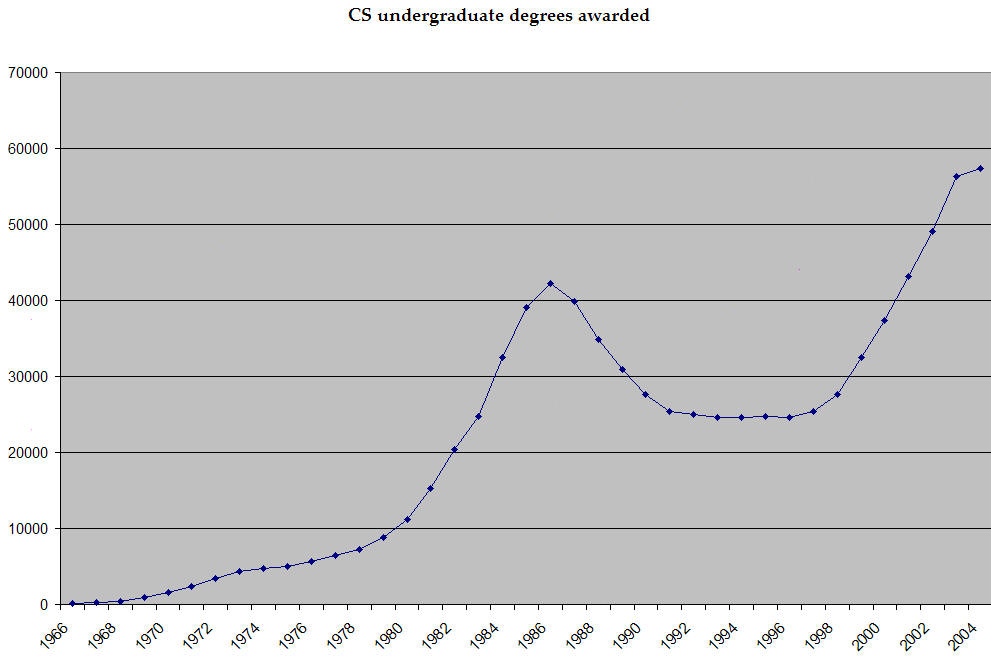The decline in computer science students (part 1)
When I gradated with my BS in computer science from Brigham Young University in 1978, we had roughly 120 undergraduate students in the CS program. When I came back to teach in 1985 — just seven years later — there were over 1,000 undergraduate students in the program, and you actually had to apply to the CS program and be accepted in order to major in computer science.
Thanks to the Computing Research Association, I’ve found the National Science Foundation data that shows this was a national trend and a very real spike — and that I taught right at what would be the peak of CS degrees awarded (1985-87) for almost a decade:
(Click for larger view. Note: the NSF source has no data from undergraduate CS degrees for 1999; the value used above for 1999 is interpolated from 1998 to 2000.)
From what I could tell as a CS instructor during that period, this massive surge of enrollment was due largely to the hype surround the advent of personal computers, with a particular focus on the attention given to Steve Jobs at Apple and Bill Gates at Microsoft. However, the personal computer industry went through what I call the First Tech Crash starting roughly in 1988. Lots of personal computer hardware and software companies shrunk in size or went out of business altogether, so that by 1990, the running joke around Silicon Valley was: “Do you know what the status symbol of the 90s is? A job.”
Not surprisingly, the dot.com craze of the late 1990s triggered another explosion in computer science enrollment and degrees, clearly shown on the table above. What is not shown on the table above is that the Great Tech Crash of 2000 significantly depressed the job market for students graduating in the 2000-2004 timeframe.
The results has been a decline in both CS enrollment and undergraduate degrees granted. Here’s a chart from the CRA reflecting a decline in CS undergrad enrollment since 2000:
As you can see, the percentage of undergraduates declaring a major in computer science has dropped to a level not seen since just a few years after I graduated in 1978. The decline appears to have leveled off for now, but it’s still a bit staggering, according to the CRA (emphasis mine):
After seven years of declines, the number of new CS majors in fall 2007 was half of what it was in fall 2000 (15,958 versus 7,915). Nevertheless, the number of new majors was flat in 2006 and slightly increased in 2007. This might indicate that interest is stabilizing.
The decrease in new majors has meant that the number of students enrolled in CS has fallen for several years (Figure 2). Between 2005/2006 and 2006/2007, enrollments went down 18 percent to 28,675. Overall, enrollments dropped 49 percent from their height in 2001/2002, while the median number of students enrolled in each department fell 53 percent since 2000/2001.
The NSA data only goes up to 2004, so it doesn’t reflect the corresponding decline in CS degrees awarded — that won’t start showing up until 2005. But the second table above shows how closely enrollments and degrees track (when time-shifted by 4 years).
In my next post, I’ll talk about what I believe are some of the factors that cause these up-and-down trends in CS enrollment and degrees. ..bruce..



Comments (4)
Trackback URL | Comments RSS Feed
Sites That Link to this Post